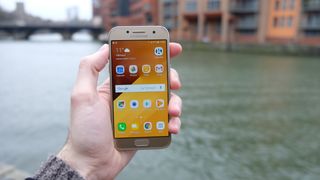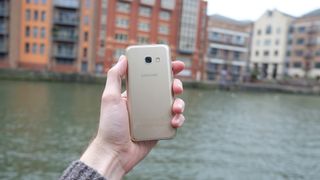TechRadar Verdict
Samsung has created another solid mid-range smartphone contender, and this one looks and feels more like its high-end brothers than ever.
Pros
- +
Galaxy S7-like design
- +
Excellent battery life
- +
Water and dust resistant
Cons
- -
720p display underwhelms
- -
Samsung software still sub-par
- -
Camera yields mixed results
Why you can trust TechRadar
Samsung has significantly closed the design gap between its top and mid-range phones with the new Samsung Galaxy A3 2017. But it's not the only manufacturer making desirable phones for an affordable price.
In fact, the South Korean firm isn't the front runner in the budget market with strong competition from the likes of Motorola, Huawei, Honor, Oppo and Wileyfox (in the UK).
What Samsung has done here though is clever, it's taken the design language from its premium Galaxy S range and brought it to an entry-level handset - which means you don't feel like you're completely missing out if the likes of the Galaxy S8 and Galaxy S8 Plus are financially out of reach.
Samsung Galaxy A3 price and release date
- Launch price: £279 ($250, around AU$455) SIM free
- Current price: £225 ($250, around AU$375)
- Release date: January 2017

Weight: 138g
Dimensions: 135.4 x 66.2 x 7.9mm
OS: Android 7
Screen size: 4.7 inches
Resolution: 720 x 1280
CPU: Exynos 7870
RAM: 2GB
Storage: 16GB
Battery: 2,350mAh
Rear camera: 13MP
Front camera: 8MP
The Samsung Galaxy A3 launch price was £279 ($250, around AU$455) for this SIM free 2017 edition, which is a little more than half the price of the Samsung Galaxy S7 Edge.
Since its arrival though, the price has dropped if you shop around, and we've seen the Galaxy A3 as low as £217 on Amazon. - which represents a healthy price drop.
This price point puts it in direct competition with a host of impressive mid-rangers, such as the Moto G5 Plus, Wileyfox Swift 2 X and Honor 9 Lite.
The Galaxy A3 is widely available in the UK, with major networks and retailers and networks stocking the handset, while in the US it can be found online at the likes of Amazon.
Dressed to impress
- A premium design
- Water and dust resistance
Samsung's biggest achievement with the Galaxy A3 2017 has been to make a phone that looks and feels a lot like the Samsung Galaxy S7 for a couple of hundred pounds less.
We'll go into the specifics of the A3’s design in the following section. Suffice to say that it follows the design language of its premium brother to a quite impressive degree.
It's got an all-metal rim, a familiar curved '3D Glass' back, and even a slightly shimmery effect to its front bezels. Anyone who's used a Samsung Galaxy S6 or Galaxy S7 for an extended period will be able to detect the differences, but it's a creditable approximation regardless.
You even get IP68 certification, which means that the Samsung Galaxy A3 2017 is as resistant to water and dust ingress as its big brother. That's not something we're accustomed to seeing on cheaper phones, so it’s a notable bragging point for the new A3.

Samsung seems determined that you won’t easily spot the difference through a cursory glance of the Galaxy A3's spec sheet either, with the presence of a custom Exynos 7870 CPU, a 13MP main camera, and a front-mounted fingerprint sensor all suggestive of higher end thrills.
Closer scrutiny of those components affirms their mid-range status, but they're not found wanting at this price point.
One forward-looking component the Samsung Galaxy S7 doesn’t have that the Samsung Galaxy A3 2017 does is a USB-C port. It's not a massive bragging point, but it's certainly the standard we're expecting to see all mid to high-end Android phones adopting in 2017.
From a practical perspective it's much easier to plug in a charger or cable without looking, thanks to USB-C's reversible nature.
Design and display
- Design mimics Galaxy S7 nicely
- Bright and colourful 4.7-inch AMOLED display
- 720p resolution doesn’t seem sufficient
We've already acknowledged that the Samsung Galaxy A3 2017 does a great job appropriating the design language of the Samsung Galaxy S7 with relatively few compromises. But more importantly, it simply feels great in the hand.
At 7.9mm thick and weighing 138g, and combined with that metal and glass build, it has a similar 'just-so' heft to the one you get with Apple's iPhones. You know you're holding something of quality, but it won't remind you of the fact when it's sat in your pocket.
Meanwhile, that 3D Glass back is more than just a visual flourish - it ensures that the phone sits nicely in the curve of your hand.

We're still not convinced that an all-glass back is a particularly practical idea in a phone, though. In fact, we're pretty sure it isn't.
It makes the phone feel precariously slippery when you're fishing it out of your pocket, and we suspect it will be extra-prone to scuffing and cracking should that evasiveness ever manifest itself and it heads for the floor.
We're not massively enamored with the Gold Sand color our test unit came in, but that's obviously a subjective matter. There are Black Sky and Blue Mist options for those who like their phones to be a little more understated, and a Peach Cloud option for those who, well, like pink.

We have decidedly mixed feelings about the Samsung Galaxy A3 2017's display. On paper, its 4.7-inch Super AMOLED screen with 720p resolution might sound like the kind of compact screen that can give the iPhone 7 a run for its money. But it just doesn't.
OK, so it's got that super-saturated look that AMOLED panels are known for. And you also get Samsung's usual display options, so you can tweak it according to your preference (tip: choose Basic if you want to tone things down). But that 720p resolution doesn’t seem to do this AMOLED panel any favours on the sharpness count.
It's far from bad, but anyone who's grown used to 1080p screens - as long-time Android users no doubt have - will probably notice the drop in detail, even with the smaller-than-usual screen size.
We moved straight to the A3 from using an iPhone 6S as our daily driver, which has exactly the same sized screen with a similar number of pixels, but even then the Samsung felt decidedly fuzzy and lacking a certain clarity.

We would feel churlish complaining about this perfectly adequate resolution if it weren't for the simple fact that many sub-£200/$250/AU$300 Android phones come with 1080p screens.
The difference in experience may have a genuine impact if you're an avid mobile media consumer, which we’ll discuss later.
One major advantage of the Galaxy A3's AMOLED display is that Samsung has been able to implement its Always On Display feature.
This means you can have a little clock or calendar permanently displayed in plain, dim lettering, complete with small icons for incoming notifications. It’s great for a surreptitious glance when you’re in a meeting or watching a movie.
- Thanks to Carphone Warehouse for providing us with a Samsung Galaxy A5 for review

Intel finally brings its latest laptop CPU tech to other platforms but desktop users are shunned — Meteor Lake-PS architecture fuses Core Ultra and LGA socket, targets edge systems instead

5 must-have features to future-proof your first or next EV purchase

Refreshed Mercedes-Benz EQS gets massive 55-inch Hyperscreen and an equally monstrous 511-mile range
